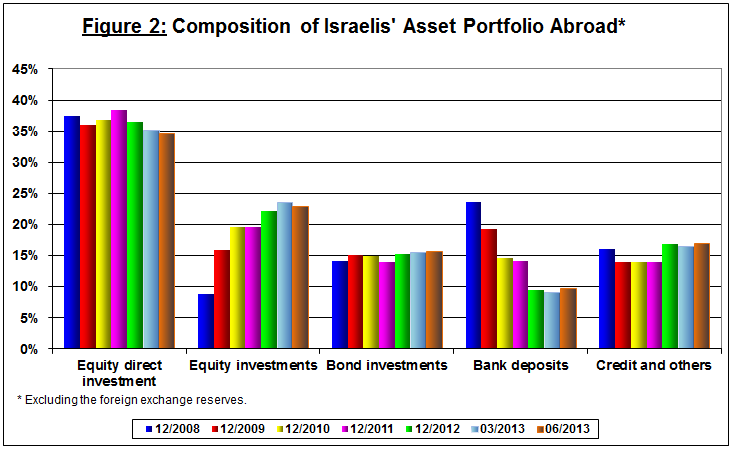Israel's International Investment Position (IIP), June 2013
Israel’s surplus assets over liabilities vis-à-vis abroad increased during the second quarter of 2013 by about $1.6 billion (2.8 percent), to about $60 billion at the end of June.
 To view this press release as a Word document
To view this press release as a Word document
 Graphs & Data
Graphs & Data
- Israel’s surplus assets over liabilities vis-à-vis abroad increased during the second quarter of 2013 by about $1.6 billion (2.8 percent), to about $60 billion at the end of June. An increase of $6.5 billion (2.3 percent) in the value of assets held abroad by Israelis was partially offset by an increase of $4.8 billion (2.1 percent) in Israelis’ liabilities abroad.
- The increase in the asset portfolio was the result of a combination of the flow of investment in bonds abroad ($1.7 billion), direct investment abroad ($0.8 billion), and an increase in deposits by Israeli banks in banks abroad ($1.3 billion).
- The increase in the gross balance of liabilities to abroad derived was due mainly to direct investments by foreign residents of about $4.7 billion (6 percent).
- The gross external debt to GDP ratio continued to decline, by another percentage point, during the second quarter of 2013, to 34.3 percent at the end of June.
- The surplus of assets over liabilities vis-à-vis abroad in debt instruments alone (negative net external debt) increased in the second quarter of 2013 by about $6 billion (8.1 percent), and reached about $79 billion at the end of June.

1. Israel's net assets abroad (the surplus of assets over liabilities) increased by about $1.6 billion (2.8 percent) during the second quarter of 2013, to around $60 billion at the end of June. An increase of $6.5 billion (2.3 percent) in the value of Israelis’ assets abroad was partially offset by an increase of $4.8 billion (2.1 percent) in the value of liabilities to abroad (Table 1, Figure 1).

2. The balance of Israel's assets abroad increased in the second quarter of 2013 by about $6.5 billion (2.3 percent), to reach about $294 billion at the end of June.
The value of the tradable securities portfolio increased by about $1 billion (1.3 percent). Net investment flow of $1.7 billion in tradable bonds abroad, mostly by institutional investors (about $0.8 billion), was partly offset by price declines in markets abroad. In contrast, there were net sales of about $260 million in foreign shares abroad.
Other investments totaled $3.2 billion, of which $1.5 billion was credit to customers and there were about $1.3 billion in net deposits by Israeli banks in foreign banks abroad.
Direct investment abroad increased by about $1 billion and was distributed among various industries.
Reserve assets increased by $1.3 billion during the second quarter of 2013.
There were only slight changes in the composition of residents' securities portfolio abroad during the second quarter of 2013—there were increases in the weight of deposits in foreign banks abroad, in credit to customers, and in bond investments, while there was a decline in the weights of stocks in the for-sale portfolio and in direct investment abroad.

3. The balance of Israel's liabilities to abroad increased during the second quarter of 2013 by about $4.8 billion (2.1 percent), and reached $235 billion at the end of June.
Direct investment in the second quarter totaled about $4.7 billion, of which about $2 billion was the result of the 'ISCAR-Buffett' deal.
The value of the tradable securities portfolio increased by $0.3 billion. About $1 billion in corporate bonds were issued, primarily by one Israeli energy company, which was partially offset by sales of government bonds abroad of about $0.8 billion. There were about $0.6 billion in net investment in stocks during the second quarter.
There were about $0.3 billion in other investments by foreign residents in the Israeli economy in the second quarter. About $1 billion in credit extended by nonresidents was partially offset by withdrawals by foreign banks from Israeli banks of about $0.8 billion.
The value of nonresidents' financial portfolio on the Tel Aviv Stock Exchange declined during the second quarter of 2013 by around $0.3 billion, and at the end of June was $29 billion. The decline is primarily the result of lower prices of shares held in the nonresidents’ financial portfolio (Figure 3).

4. The gross external debt
Israel's gross external debt declined by $0.1 billion (about 0.1 percent) between April and June of 2013, as a result of net sales by nonresidents of $0.3 billion of Israeli bonds in Israel and abroad, and net withdrawals ($0.8 billion) by foreign banks of deposits in Israeli banks. These were partially offset by an increase in credit to abroad of about $1 billion.
The ratio of gross external debt to GDP continued to decline in the second quarter of 2013, by another percentage point, to 34.3 percent at the end of June 2013. Since September 2011, the share of gross external debt to GDP has declined by about 10.5 percentage points (Figure 4).
5. The net external debt
The surplus of assets over liabilities abroad in debt instruments alone (negative net external debt) increased by about $6 billion (8.1 percent) in the second quarter of 2013, and reached $79 billion at the end of June (Figure 5).
The balance of short-term debt assets was $126 billion at the end of June 2013, a coverage ratio of 2.9 of short-term debt.
![]() To view this press release as a Word document
To view this press release as a Word document




